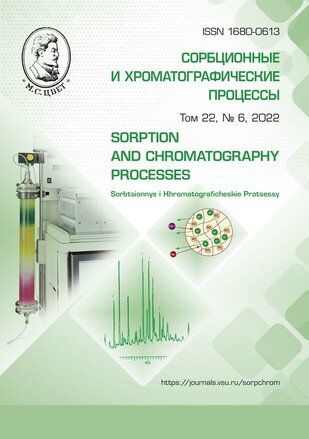Formation of the tillage pan bottom horizon in black soils and its sorption features with respect to organic matter and heavy metals
Abstract
The tillage pan horizon, which forms when black soils are ploughed, is characterised by a significant compaction of soil material and accumulation of fine elementary soil particles (ESP). This, in turn, limits the penetration depth of root systems of cultivated plants, and, as a result, leads to a decreased productivity. In our opinion, the formation of the tillage pan horizon provides the prerequisites for its increased sorption capacity with respect to organic matter and heavy metals. According to this hypothesis, the tillage pan horizon can be considered as a geochemical barrier for further vertical migration of organic matter and heavy metal salts in soils. Objectives: to establish mechanisms of the formation of the tillage pan horizon in black soils and to study its sorption properties with respect to organic matter and heavy metals, i.e. lead and cadmium.
The research involved completing the following tasks: to conduct a field study of the morphogenetic features of black soils susceptible to the formation of tillage pans; to select soil samples and to conduct a number of laboratory studies aimed at identifying their sorption properties with regard to organic matter and heavy metals (Pb and Cd); to prove that the tillage pan horizon, which has been formed in an agrogenic way, is a geochemical barrier for further vertical migration of organic matter and heavy metals.
It was established that the tillage pan horizon is formed during the arable and illuvial accumulation of fine ESPs, which exhibit sorption properties with respect to carbon of organic compounds in the soil, labile humus substances, and mobile forms of heavy metals (Pb and Cd). The horizon acts as a barrier for further active migration of the mobile fraction of organic matter and mobile heavy metal salts. The formation of tillage pans should be considered as a sign of black soil degradation since a combination of unfavourable properties (an increase in soil density and a 10% reduction in pore space as compared to the upper arable horizon) contributes to decreased plant productivity. Heavy metals accumulated due to tillage pans can contribute to their more active translocation into plant organisms and therefore degrade crop output. In this regard, a set of agrotechnical measures should be implemented to mitigate this negative phenomenon.
Downloads
References
Medvedev V.V. Fizicheskie svojstva i harakter zaleganiya pluzhnoj podoshvy v raznyh tipah pahotnyh pochv. Pochvovedenie. 2011; 12: 1487-1495. (In Russ.)
Azarov V.M., Belokurenko S.A. O pluzhnoj «podoshve». Agrarnaya nauka – sel'skomu hozyajstvu. 2017; 7-9. (In Russ.)
Alenov Zh.N., Koshen B.M., Kabdirova B.S. Metody bor'by s pluzhnoj podoshvoj v usloviyah sovremennoj sistemy obrabotki pochvy. Modern Science. 2019; 3: 12-15. (In Russ)
Zheng H., Liu W., Zheng J., Luo Y., Li R., Wang H., Qi H. Effect of longterm tillage on soil aggregates and aggregate-associated carbon in black soil of Northeast China. PLoS ONE. 2018; 13(6): e0199523. https://doi.org/10.1371/journal.pone.0199523
Dexter A.R. Model experiments on the behavior of roots at the interface between a tilled seedbed and a compacted subsoil. 2. Entry of pea and wheat roots into subsoil. Plant and Soil. 1986; 95: 135-147.
Dymov A.A., Milanovskii E.Y. Assessing the complexing properties of soil organic matter by IMAC (case study of copper ions). Eurasian Soil Science. 2020; 53. 2: 178-186. https://doi.org/10.1134/S1064229320020040
Jastrow J.D., Miller R.M., Boutton T.W. Carbon dynamics of aggregate-associated organic matter estimated by carbon-13 natural abundance. Soil Sci. Soc. Am. J. 1996; 60: 801-807.
John B., Yamashita T., Ludwig B., Flessa H. Storage of organic carbon in aggregate and density fractions of silty soils under different types of land use. Geoderma. 2005; 128: 63-79.
Schulten H.R, Leinweber P. New insights into organic–mineral particles: composition, properties and models of molecular structure. Biology Fertility Soils. 2000; 30: 399-432. https://doi.org/10.1007/s003740050020
Arthur E., de Jonge L.W., Tuller M., Moldrup P. Clay content and mineralogy, organic carbon and cation exchange capacity affect water vapour sorption hysteresis of soil. European Journal of Soil Science. 2020; 71(2): 204-214. https://doi.org/10.1111/ejss.12853
Olayemi O.P., Wallenstein M.D., Kallenbach C.M. Distribution of soil organic matter fractions are altered with soil priming. Soil Biology and Biochemistry. 2022; 164: 108494. https://doi.org/10.1016/j.soilbio.2021.108494
Piccolo A., Mbagwu J.S.C. Effects of different organic waste amendments of soil microaggregates stability and molecule sizes of humic substances. Plant Soil. 1990; 123: 27-37.
Startsev V.V., Khaydapova D.D., Degteva S.V., Dymov A.A. Soils on the southern border of the cryolithozone of European part of Russia (the Subpolar Urals) and their soil organic matter fractions and rheological behavior. Geoderma. 2020; 361. https://doi.org/10.1016/j.geoderma.2019.114006
Blair G.J., Lefroy R.D.B., Singh B.P. Development and use of a carbon management index to monitor changes in soil C pool size and turnover rate. Driven by nature: Plant litter quality and decom-position. 1997; 273-282.
Tarchitzky J., Hatcher P.G., Chen J. Properties and distribution of humic sub-stances and inorganic structurestabilizing components in particle-size fractions of cultivated Mediterranean soils. Soil Sci. 2000; 165: 328-342.
Laird D.A., Martens D.A., Kingery W.L. Nature of clayhumic complexes in an agricultural soil: chemical, biochemical and spectroscopic analysis. Soil Sci. Soc. Amer. J. 2001; 65: 1413-1418.
Chefetz B., Tarchitzcy J., Deshmukh A.P. Structural characterization of humic acids in particle-size fraction an agricultural soil. Soil Sci. Soc. Am. J. 2002; 66: 129-141.
Raj-put V.D., Minkina T.M., Kumari A., Shende S.S., Ranjan A., Barakhov A.V., Raj-put P., Sushkova S.N., Faizan M., Singh A., Khabirov I., Gromovik A., Gorbunova N., Nazarenko O., Kızılkaya R. A review on nanobioremediation approaches for restoration of contaminated soil. Eurasian Journal of Soil Science. 2022; 11: 43-60. https://doi.org/10.18393/EJSS.990605
Yakovets L. Migration of heavy metals in the soil profile. Norwegian Jour-nal of Development of the International Science. 2021; 54-1: 8-12. https://doi.org/10.24412/3453-9875-2021-54-1-8-12
Sabitova A.N., Bayakhmetova B.B., Mussabayeva B.Kh., Orazhanova L.K., Ganiyeva K.G. Sorption of heavy metals by humic acids of chestnut soils. Bulletin of the Karaganda University. Chemistry Series. 2020; 3 (99): 88-98. https://doi.org/10.31489/2020Ch3/88-98
Zhang Y., Zhen Q., Xin J., Yuan Y., Wu Z., Zhang X., Cui Y., Li P. Storage of soil organic carbon and its spatial variability in an agropastoral ecotone of Northern China. Sustainability. 2020; 12. 6: 2259. https://doi.org/10.3390/su12062259







